
© Steve Disenhof. (Click image for larger version)
Robert Moses’ Kin
23rd Season: Speaking Ill of the Dead, Trapdoors/Trickbags/Painted Corners, Lucifer’s Prance, Bootstrap Tales
★★★★✰
San Francisco, Yerba Buena Center for the Arts
23 February 2018
www.robertmoseskin.org
www.ybca.org
With the wings removed, the stage was bare and raw. One dancer crossed the expanse inch by inch, her hands grabbing an imaginary rope for support and assistance. Another dancer crouched in a pool of light downstage left, his back to the audience, face hidden. Then a series of duets unfolded. Two at a time, the company cycled into the pool of light. They picked each other up off the floor and caught one another in full body falls, every motion supported with a desperate intensity. No two were onstage for very long, but every dancer would reappear several times. They were present then absent, present then absent and present then absent once more. And as the collage of duets went on, you noticed that all the choreography had remained within this one spot on the stage, purposely limited and contained.
With these first movement phrases, Robert Moses’ Kin’s Bootstrap Tales was underway, the centerpiece of the company’s twenty-third home season, which opened Friday night at Yerba Buena Center for the Arts. For this new ensemble work, Founder and Artistic Director Robert Moses looked to The Bootstrap Program, an outreach platform launched by the company in 2017. Currently in its development stage, The Bootstrap Program hopes to connect youth in the San Francisco foster care system with an arts-driven curriculum. Workshops will explore the numerous paths and tracks within the performing arts (dance, costume making, set design and building, stagecraft, new media, arts administration and more), and equip foster youth with connections to these fields.
And so, the choreography for Bootstrap Tales abides in a place where possibility, gumption and empowerment meet. The atmosphere of moving forward is palpable. Yet at the same time, the piece appropriately ventures outside of the optimistic. Moses equally unpacks themes of isolation and upheaval. And, with the piece centered on an oft forgotten population, Bootstrap Tales makes an uncanny comment on visibility, including an extra layer with the score. Street musicians, another community that is so frequently passed by and dismissed, contributed original material for the score. Vocals, spoken word, percussion, piano and fiddle were then masterfully compiled together by PC Muñoz (Moses and Muñoz also contributed sound and music elements). Bootstrap Tales is such a well-balanced dance, one that leaves you with an unmistakable ‘care hard’ charge – care about the future, care about what you do, care about people around you, just care.
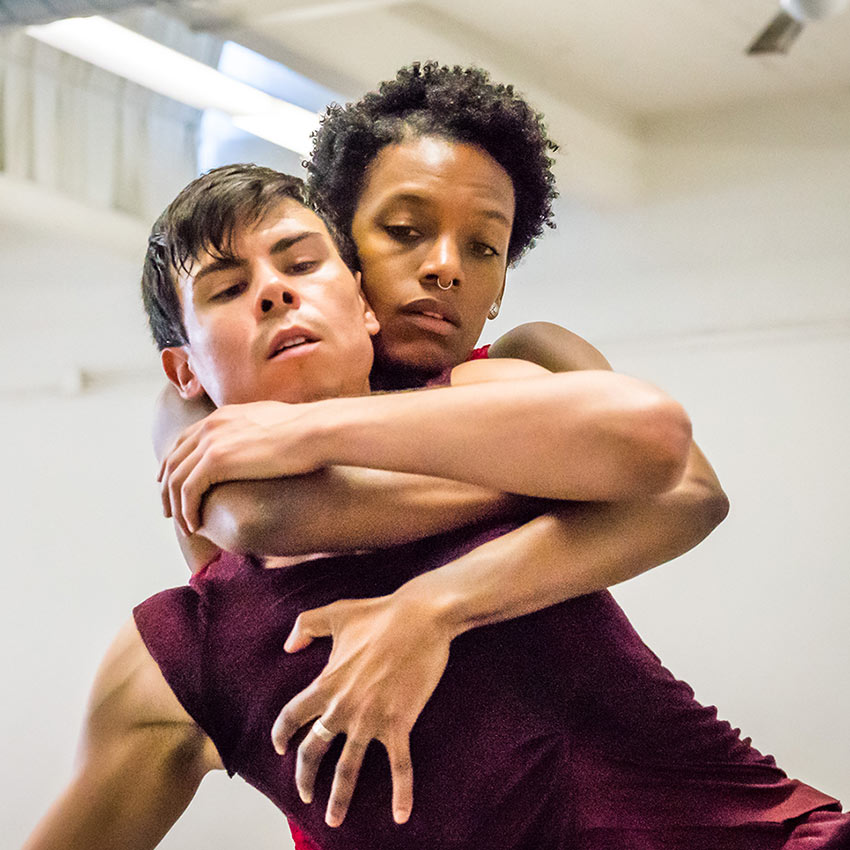
© Steve Disenhof. (Click image for larger version)
As the piece continued and different cast groupings occupied the stage, the thematic scope of Bootstrap Tales was fully revealed. An early solo found Alivia Schaffer dancing alone, while six dancers posed in the background. She stretched her arms out into the space, searching for the others. She couldn’t physically reach them or see them, but they stood firm. Perhaps she could at least feel their presence. Mid-way through, Crystaldawn Bell and Norma Fong offered a stunning duet. Their core, legs and arms intertwined like a cat’s cradle string game. But more so, the duet carved out a distinct presence in the space, one that was uniquely theirs. Khala Brannigan’s variation toggled between extreme frenetic shaking and free, unencumbered physicality. In one moment, she would be caught up in the vibrating ruminations. Then all of sudden, the hands and legs that had been violently pulsing would relax and extend, seemingly free from constraint. Vincent Chavez eventually joined Brannigan, on a similar course – at first paralyzed by repetitive, uncontrolled circumstances, while a later reprieve brought joy and delight.
One sequence for the company’s women particularly struck. As five watched, Fong shared a choreographic musing, with them and with the audience. One by one, each dancer began to take on Fong’s movement, but they were only appropriating the general frame. Each step and gesture was in their own time and with their own unique articulation and dynamic phrasing. Togetherness and community was found in the shared movement as much as individuality was found in the different interpretations. Embraces in the dance were sometimes welcome, sometimes not. And Moses peppered the choreography with social dance influences – lifts and counterbalances that needed another person in order to be fully realized.
In Bootstrap Tales’ brilliant coda, Moses left us with an unanswered question to ponder. The dance’s first soloist began her final movement phrase. Her partner lingered behind her, reacting with curiosity to her movement. He looked as if he wanted to engage and connect, and yet, seemed hesitant and unsure. As the curtain fell, he was still in the process of figuring out the next step. His journey was neither at the beginning nor at the end, it was somewhere in the middle.
Prior to the world premiere of Bootstrap Tales, the company offered three shorter works from the last eighteen years: Speaking Ill of the Dead (2006), an excerpted solo from Trapdoors/Trickbags/Painted Corners (2017), and a revival of 2000’s Lucifer’s Prance. With a dimly lit stage, black costuming and the sound of military drums, the ominous nature of Speaking was clear and convincing from the very start. Charged choreography was infused with abrupt stopping points and sharp directional shifts, as if the dancers were being constantly jolted and shocked by new realities and circumstances. And as Fong jetéd over the mens’ bodies lying facedown in a rectangular pool of light, grief and despair erupted from the stage.
Crystaldawn Bell completely hypnotized in the only solo on the program, an excerpt from Trapdoors, a powerful statement on race, told by women of color. Instead of music or sounds, Trapdoors’ score is made up of interviews with different women. Each shared their personal narratives, which ranged from incidents of unfair bias and blatant profiling to touching stories of family and community. Bell added her own experience to the mix with dance. Her legs extended far into the space, beyond what even seemed possible. Her hands emphasized the strength of her core, and also gently and affectionately circled her face. This was one of those rare solos where I didn’t make any notes during the performance. I was totally captivated by what was happening on the stage, not wanting to miss a second of Trapdoors’ potency.
The curtain rose to reveal the company costumed in crimson and scarlet reds, posed all over the stage for Lucifer’s Prance. In this piece, it was the intersection of movement genres that stood out. Controlled positions and turned out shapes spoke of lyricism and ballet. Warrior stances and side planks of yoga. Hands gathered into fists, jabbing the space with repeated uppercuts. Big jumps met intricate foot percussion. And with its floorwork emphasis and chorus energy, the final group segment conjured images from Martha Graham’s incomparable Acts of Light (1981). Lucifer’s Prance contained a broad swath of physical vocabulary, and with Moses’ talent for choreographic orchestration, the combination totally worked.










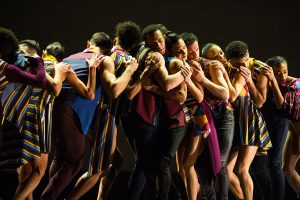

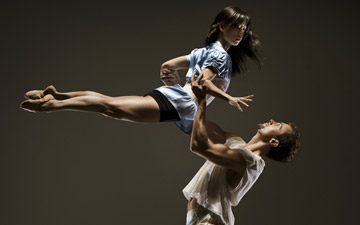
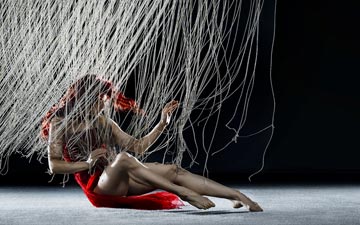
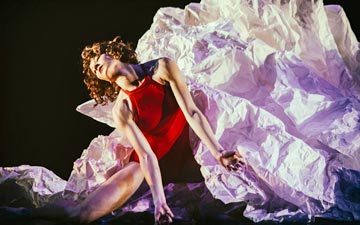


You must be logged in to post a comment.